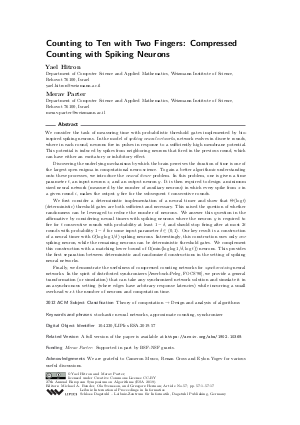@InProceedings{hitron_et_al:LIPIcs.ESA.2019.57,
author = {Hitron, Yael and Parter, Merav},
title = {{Counting to Ten with Two Fingers: Compressed Counting with Spiking Neurons}},
booktitle = {27th Annual European Symposium on Algorithms (ESA 2019)},
pages = {57:1--57:17},
series = {Leibniz International Proceedings in Informatics (LIPIcs)},
ISBN = {978-3-95977-124-5},
ISSN = {1868-8969},
year = {2019},
volume = {144},
editor = {Bender, Michael A. and Svensson, Ola and Herman, Grzegorz},
publisher = {Schloss Dagstuhl -- Leibniz-Zentrum f{\"u}r Informatik},
address = {Dagstuhl, Germany},
URL = {https://drops.dagstuhl.de/entities/document/10.4230/LIPIcs.ESA.2019.57},
URN = {urn:nbn:de:0030-drops-111782},
doi = {10.4230/LIPIcs.ESA.2019.57},
annote = {Keywords: stochastic neural networks, approximate counting, synchronizer}
}

 Creative Commons Attribution 3.0 Unported license
Creative Commons Attribution 3.0 Unported license




























